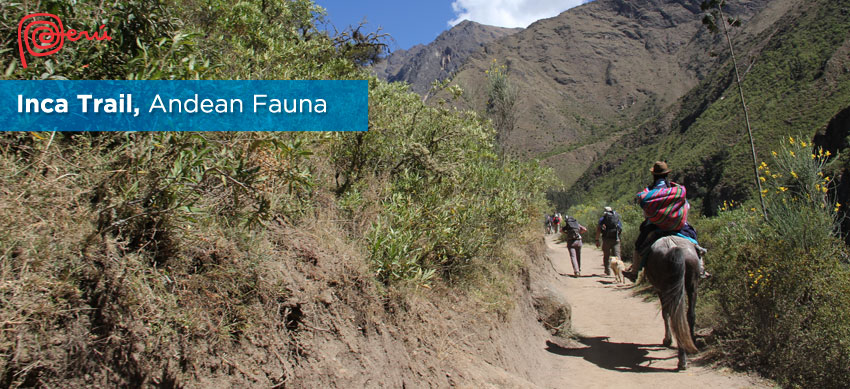
The Cordillera de los Andes is an immense chain of mountains of 8,500 kilometers in length (the longest on the planet) that covers extensive regions of Peru, Bolivia, Venezuela, Colombia, Ecuador, Chile and Argentina. During the Inca Trail to Machu Picchu, 39 kilometers of the mountain range are covered. Know what landscapes you will see during this historic walk in the heart of the Andes.
The Inca Trail is a demanding hiking route as it runs through challenging geographies of the Andes Mountains. In addition to the 39 kilometers that the visitor crosses on foot (in 4 days and 3 nights of camping), one must fight against the lack of oxygen due to the high altitude of the mountains. This is called altitude sickness and can cause fatigue, nausea, and excessive agitation when exerting yourself. In general, the Inca Trail is a moderate route. However, due to its location in the Andes Mountains, it can become quite a challenge for tourists.
The Andes Mountains
The Andes Mountains is an extensive chain of mountains and peaks that covers a length of 8,500 kilometers. It is the largest in the world. It crosses seven countries in South America: Peru, Bolivia, Venezuela, Colombia, Ecuador, Chile and Argentina.
The Incas adapted to the challenging geography of the Andes Mountains. This is how they located the capital of their enormous empire in the city of Cusco. From there they built roads (the qhapac ñan) for more than 30 thousand kilometers along the coast and, above all, the mountain range.
A small part of these roads is what connects the city of Cusco with Machu Picchu. Currently there is a 39-kilometer tourist route that runs through these roads. The journey is done on foot in 4 days and 3 nights. The final destination is Machu Picchu. The ‘Inca Trail’ offers incredible landscapes of the Andes Mountains.
The Inca Trail and the Andes Mountains
In the first two days of the Inca Trail, high mountain landscapes are crossed. The walks are demanding as they are ascending hundreds of stone steps built by the Incas. From the starting point (at kilometer 82) to the second Pacaymayo camp, approximately 28 kilometers are crossed.
In the last two days of the Inca Trail, you descend through the tropical jungles of the eastern part of the Andes Mountains. The walk becomes easier because it is descending through hundreds of Inca stairs and trails. From the second camp to Machu Picchu, approximately 11 kilometers are crossed.
Andean flora and fauna on the route
During the Inca Trail to Machu Picchu you can appreciate these Andean flora and fauna species:
- Orchids (Orchidaceae) – This family of flowers stand out for their colorful petals. On the Inca Trail they can be seen, especially in the tropical forests. It is believed that in the Historic Sanctuary of Machu Picchu there are more than 300 species.
- The Andean condor (vultur gryphus) – This bird is the second largest flying species on the planet (the first is the albatross). Fly over the high Andean mountains. Sometimes it also forages its food on the arid sea coasts. They are scavengers. It has black and white feathers. It is a symbol of many countries in South America.
- Andean bear (tremarctos ornatus) – Known as the spectacled bear, it is one of the eight species that exist in the world and only live in the Andean Amazon region of South America, being Peru, the country that has the largest amount of population of this species, it is likely that it see.
- Cock-of-the-rock (rupicola peruviana) – This national bird of Peru, famous for its plumage and colorful display for courtship; on the walk from the town of Aguas Calientes to Mándor, very early in the mountain you can see him.
- The guanaco (lama guanicoe) – It is one of the 4 camelids that live in South America, they eat grass, roots and subsist precariously.
- The vicuña (vicugna) – It is an endangered animal and is protected from hunters because its wool is very soft and of great value; with a yield of only 250 grams per shear, and only four to five shears per vicuña. It lives in the high Andean areas.
- The vizcacha (lagidium viscacia) – These rodents resemble rabbits and squirrels. They are characterized by their abundant fur and erect ears. It inhabits the cold Andean highlands.
More information
Peru is a privileged country home to part of the planet’s biological diversity with 84 of the 104 life zones. The SERNANP (National Service of Natural Areas Protected by the State), has the vision of ensuring the conservation of natural areas, their flora and fauna. It has also been in charge of disseminating the diversity of fauna species that exists in our country.
In Peru and its protected areas stand out: more than 2,000 species of fish, more than 4,000 species of butterflies, more than 1m816 species of birds, more than 449 species of amphibians and more. It should be noted that of the 83 species of cetaceans in the world, 36 are found in Peru.
The Andes Mountains are mainly characterized by high mountain ranges that exceed 3,000 meters above sea level. On the Inca Trail this causes the visitor to suffer from the famous ‘altitude sickness’ caused by the high altitude. To reduce symptoms, it is recommended to drink plenty of water and allow the body to acclimatize (two days in the city of Cusco is the most recommended).
By Inca Trail Machu Picchu - Last updated, 22-08-2024
Interested in the Inca Trail? Know more about Nature!
- Coca leaf, ideal for trekking in Peru
- The Cantuta flower. Where to find it on the Inca Trail?
- Fauna of the Inca Trail
- Spectacled bear on the Inca Trail to Machu Picchu
- The cock of the rocks on the Inca Trail
- Inca Trail: butterfly observatory
